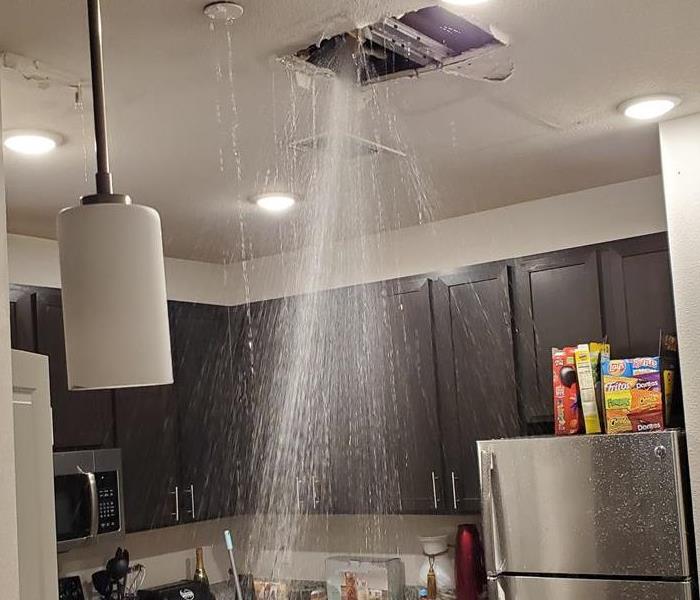Recent Water Damage Posts
Suspected Leak
7/18/2024 (Permalink)
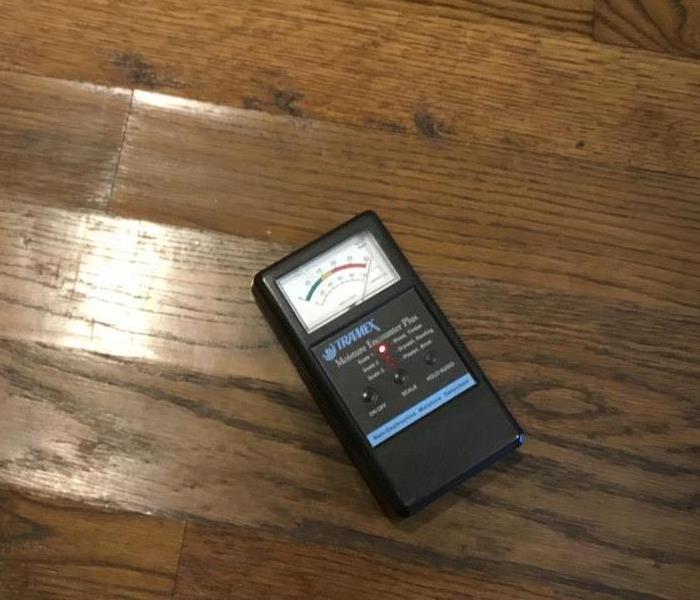 Moisture meter on affected wood flooring.
Moisture meter on affected wood flooring.
Sometimes we find that homeowners suspect that they have a leak, but are unsure of the cause and/or the extent of the water damages. Our trained technicians use thermal cameras and moisture meters to help try and pinpoint the source of the leak, as well as determine the extent of the damages. For example, drywall may look "dry", but the thermal camera and moisture meters can determine if there is excess moisture in an area. Some telltale signs of a leak may be cupping floors or baseboards separating from the walls. If it is determined that there is water damage, our team can place some drying equipment to help keep things stabilized until the leak is fixed and the area can be effectively dried.
What is a Deductible on an Insurance Claim?
8/22/2023 (Permalink)
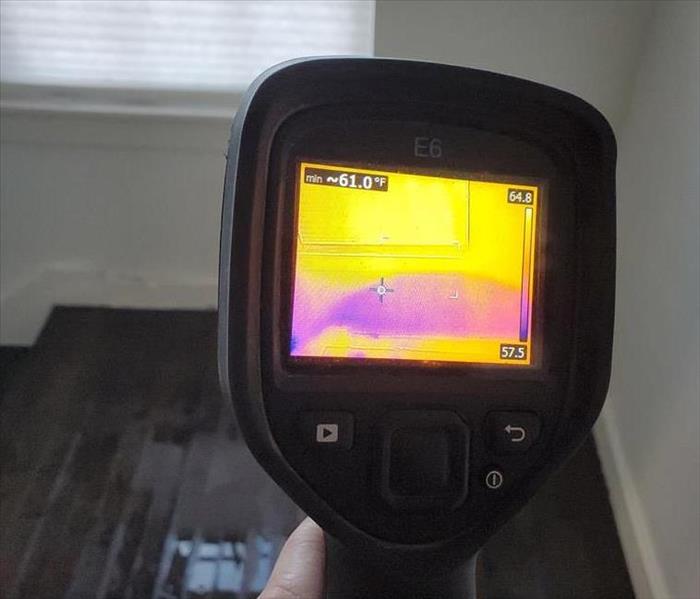 Lakewood house with water in walls and buckling floors from a faulty water heater
Lakewood house with water in walls and buckling floors from a faulty water heater
Home Insurance in Texas
In Texas, homeowners are not required to have Home Insurance but if you have a mortgage on your home, your mortgage company may require it. Though it is not required, it is heavily recommended.
What is a Deductible?
The most common reasons for a home insurance claim are wind and hail damage, water and freezing damage, fire damage, and theft. Home insurance is typically paid on a monthly basis and often for years before it is needed. Deductibles can be a flat amount or a percent of the home value. This can often range between $500-$2,000 or 1-2%. The insured will pay the deductible amount, with the insurance company usually covering everything above and beyond that amount. For example, the average fire damage claim is around $80,000. If the deductible was $2,000, the insured would pay that amount with the remaining $78,000 being paid by the insurance company.
When to Make an Insurance Claim
When an issue arises that may cause the need for water damage mitigation or fire damage restoration services, it is worth determining the cost to fix the issue before making an insurance claim. Using the example mentioned above, if the cost to take care of the problem is below the deductible, a claim should not be made. Often if the cost is slightly above the deductible, it may not be worth making a claim. Calling insurance to make a claim and not actually following through with the claim can cause what is known as a zero-dollar claim. Though the homeowner did not officially get any monetary benefit from the insurance company, it is now on their record and typically results in an increase in the monthly insurance rates going forward.
Who to Call for Help?
A call to a professional mitigation/restoration company like the experts at SERVPRO of Southwest Dallas. They can assist in surveying the damage, coming up with a plan and an estimate to help with your claim decision.
Fires Often Cause Water and Fire Damage Especially In Commercial Properties
5/5/2023 (Permalink)
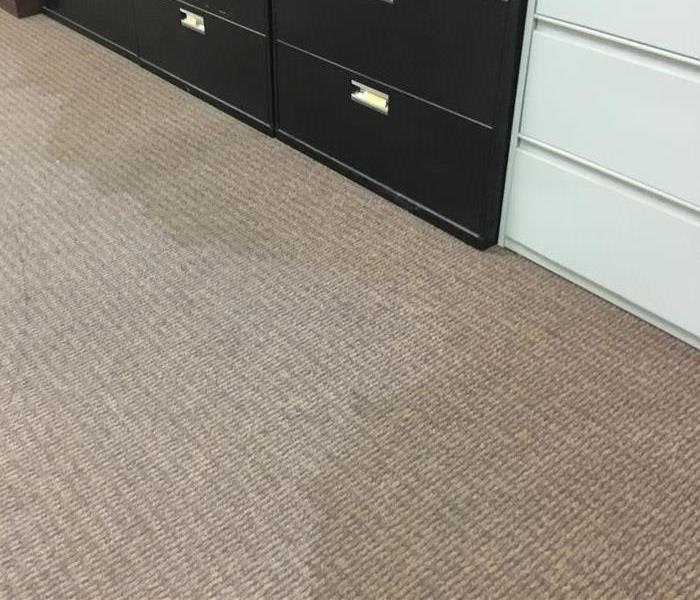 A fire in a Grand Prairie commercial office causes water and fire damage
A fire in a Grand Prairie commercial office causes water and fire damage
No one ever wants to fire damage but water damage is not often thought of in the same breath. When a fire or even just a fire alarm occurs in a commercial building, procedures may require the fire department to be called. If an actual fire is in play, the fire team will typically spray water and punch holes in the ceiling.
A second source of water can actually before the firefighters even arrive. Most commercial buildings are outfitted with sprinkler systems. Depending on age and working condition, these can keep the water distribution confined to a room or soak a whole floor or building with water.
One recent example SERVPRO of Southwest Dallas had was a small electrical fire in a commercial office space that also had an adjoining warehouse. The sprinkler heads went off thankfully just in the affected area with the firefighters adding a second layer of water to make sure the fire was out.
Before attacking the fire issue, the water damage must first be addressed. Especially after a fire, electrical can be a problem so things must proceed cautiously. As much extraction is done as possible and drying equipment place strategically in hopes of drying things quickly so the next step, fire restoration can begin.
It can be long process depending on the size of the property and amount of contents involved.
At SERVPRO of Southwest Dallas, we are here to make it "Like it never even happened."
What is the Difference between Mitigation vs Restoration vs Remediation?
7/11/2022 (Permalink)
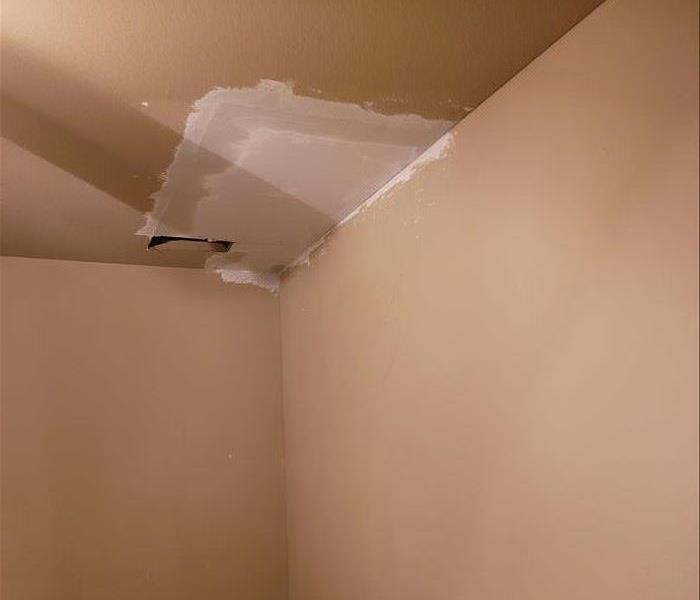 Water Damage Caused a Small Area of a Ceiling to Collapse with the Need for a Drywall Patch, Texture and Paint
Water Damage Caused a Small Area of a Ceiling to Collapse with the Need for a Drywall Patch, Texture and Paint
When there is a water damage issue at a residential or commercial property, you will often hear the terms “Mitigation, Restoration or Remediation” being used. While they seem like they may be similar that actually mean very different things:
Mitigation – reducing the severity, seriousness or painfulness of something
Restoration – returning something to a former condition
Remediation – the act of remedying or correcting something, usually cleaning up, reversing or stopping environmental damage
What using the term “Mitigation” in a water damage situation, it is referring to extracting water and drying out the structure or contents so no further damage can occur. Water is very invasive and can get into just about any area of a home and cause damage. This can not only be in the form of direct water but also secondary damage from high humidity. The sooner water can be removed and humidity brought down to normal levels, the better chance of salvaging more contents and structure.
When the term “Restoration” is used, it is referring to restoring the property or contents to it’s pre-water damage state. This can mean new paint, new floor, replacing baseboards, etc. Making it look like the water damage never even happened.
When the term “Remediation” is used in a water damage circumstance, it is normally referring to killing and/or removing mold that may have formed. Mold can cause a variety of issues for a homeowner. It is important to get it taken care of so the structure can be safely reoccupied.
It you have a water damage and need mitigation, restoration or remediation assistance, please give us a call at SERVPRO of Southwest Dallas 214-463-5880.
Why Local & At the Curb Shutoffs are Important
5/3/2022 (Permalink)
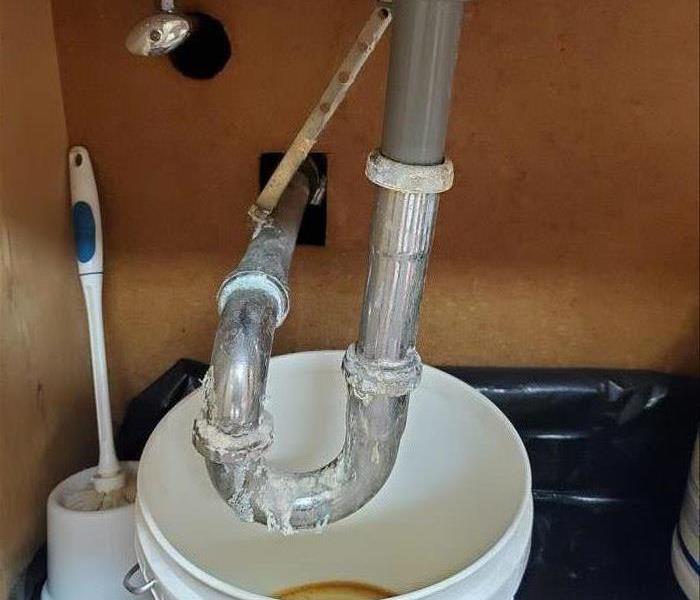 A dripping pipe under a sink, know where your shutoff valve is located!
A dripping pipe under a sink, know where your shutoff valve is located!
At SERVPRO of Southwest Dallas, we have happened upon some very interesting scenes when we arrive onsite at a water damage issue. But even before being onsite, we get very panicked calls about water pouring from kitchen sink pipes, washing machines, toilets or a host of other items throughout the house. Our first question is usually has the water been stopped. If not, the water has to be stopped before water mitigation and restoration process can begin. Stopping the issue can either mean a plumber has already been called and is fixing the issue or the water needs to be shut off locally or at the curb. If the plumber in already involved, he or she has most likely has already taken the step of turning off the water in the home in order to fix the problem.
Turning off the water locally refers to locating what is usually a knob or lever at the area of the issue for example under a sink or a hot water heater and rotating clockwise until water is no longer flowing. There still may be dripping going on. Sometimes it is not possible to turn off the water locally as the pipe is broken beyond where the valve is located or there is an issue with the valve itself. It is usually advisable to turn off water locally when possible as it will still allow use of water throughout all areas of the house except for the area of concern.
The next solution is to turn off the water at the curb. There are many underground pipes that are hidden from everyday view. Water flows from a central pipe usually under the street area by the curb through a shutoff point and continues to each home. The shutoff point is also known as the water box. This is where home owners and tenants have access to shut off the water to the entire house.
These days, most of the water shut off boxes are made of plastic and are fairly easily accessible. The other main water box that you see still are circular, cast iron boxes. These will often need a special key to remove the lid. Once inside the water box, a water key is needed to turn the water off. These can be a variety of types and can be found on Amazon.
It is a good idea to make sure you know where your water box is located. And the next step would be to make sure you have the appropriate water key on hand. Additionally, make sure that the water box is cleared of any debris or tree roots. It is a good idea to check once a year to make sure no new sediment has filled up your water box so you have no obstacles should an emergency arise.
Should water damage affect your home, please reach out to us, we are more than happy to help mitigate and restore your property.
Cold Weather is Coming to North Texas, Here are Some Tips
2/1/2022 (Permalink)
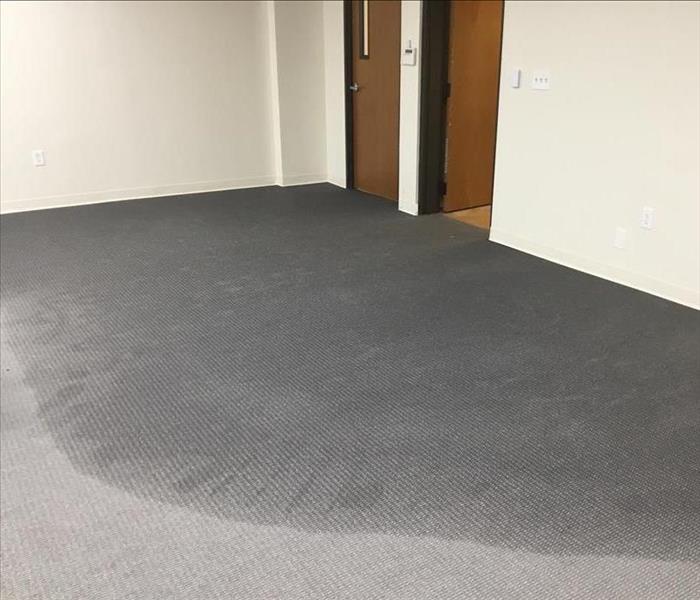 A Large, Carpeted Room Flooded from a Broken Sink Pipe
A Large, Carpeted Room Flooded from a Broken Sink Pipe
The cold weather is coming to North Texas. It is always a good refresher to review key tips to help prevent pipes from freezing and breaking:
- Open all water faucets in your home to allow a very thin trickle of water to flow through the water lines (both hot and cold). Allow the trickle of water to continue to flow throughout the night.
- Leave all drains open, and do not leave anything in the sinks as such items may cause drains to become clogged and possibly cause flooding of your home
- Leave all cabinet doors underneath sinks and lavatories open so the water pipes will remain ventilated with warm air.
- When not at home, leave bathroom doors open.
- Leave the heat turned to "Auto" and thermostat set at no less than 65 degrees, especially if you will be gone for more than 24 hours.
- If you turn on a faucet and no water comes out, you should immediately contact a plumber. This may indicate pipes have already frozen in your home. Be sure to turn the faucet back off until the plumber arrives.
- Check your curbside water box and make sure the turn off is not buried or clogged up with tree roots or weeds.
- Make sure you and your kids know how to turn off the water locally in every room and at the curb.
- Pay attention to noisy pipes and moisture on walls or floors and rust stained water.
We hope these tips help prevent any damage but if something does happen don't hesitate to reach out to SERVPRO of Southwest Dallas, we are always here to help.
Steps to Take After a Home or Property Flood
11/8/2021 (Permalink)
Threatening the integrity of a building and endangering those within, flooding can result from numerous causes. Faulty plumbing, broken appliances, storms, and more can result in flooding and water damage. Once the water source has discontinued – either naturally or through repair – what's left? Pooled water, damage to floors, walls, structures, and more can be the final product of a flood or even a slow but prolonged leak.
After water damage, can you restore your home or company building yourself? This can be a tricky business and poses dangers of a varying nature. Safety measures must be taken, some expertise must be applied, the gravity of the situation must be recognized in no uncertain terms – the list goes on.
Let's take a look at water damage and how to handle it.
What Are the Damaged Materials?
Water can damage everything it touches, no matter what kind of building the leakage and/or damage occurs in. Everything inside or involved in the structure is prone to harm including devices, wiring, the floor, walls, etc. To know whether or not this clean-up is a do-it-yourself project, you must survey the extent of damage.
Is the drywall damaged? For days following a leak or flood, drywall can hold on to water. This can threaten the integrity of a building. To make your walls and ceiling look like new again, complete replacement of plaster/drywall may be necessary.
Some areas might just need some drying out. You may be able to salvage wooden pillars, furniture, etc., but this is on a case-by-case basis. Most often, after flooding, electrical appliances and carpeting will need to be removed and disposed of properly.
If you suspect possible damage with asbestos, call a professional immediately.
During Clean-Up – What Should You Expect?
Both water and debris will need to be cleared from a flooded area. Due to muddy floodwaters, insects and certain animals may be attracted to the property. While cleaning the area, don't be surprised if you have to deal with insects, snakes, rats, and more.
If a floor feels like it's sinking in or drooping, be extremely careful walking in the area. If you're not sure where it's safe to step, you can get hurt. Avoid going into a structure that looks like it's falling apart.
Tips and Precautions
PPE (personal protective equipment) and clothing should always be worn when cleaning up or dealing with water contamination, water damage, etc.
To remove water and mud from your property, you cannot use a regular vacuum cleaner. Dehumidifiers, heavy-duty fans, and commercial wet vacs should be used.
To avoid infection, after drying, areas must be thoroughly cleaned and/or sanitized. For services like ceilings and walls, detergent and warm water may suffice. However, hot water and soap are recommended for dirty items like dishes, cooking utensils, silverware, and more.
The Best Advice For Handling Water Damage
If your home or business has experienced water damage, you may not want to attempt repair and/or restoration on your own. It can be extremely difficult to deal with and even unsafe. But, if you contact the water damage experts at SERVPRO, you can begin the process of post water damage recovery in expedited fashion.
Set your mind at ease by letting certified and experienced professionals take care of the problem. Do you have water damage? Don't wait another moment. Contact us today.
Tips For Flood Proofing Your Home
10/20/2021 (Permalink)
Flood-Proofing Tips for Your Home
Floods can happen almost anywhere and are among the most costly and common natural disasters in the United States. If you own a home in DFW, you’ll want to protect it. By being prepared, as outlined below to flood-proof, you can prevent costly damage to your home and the need for expensive repairs in the future. Please don't hesitate to contact SERVPRO of Southwest Dallas at 214-463-5880 if you do happen to find your home in the Dallas Metroplex flooded.
1. Reposition Indoor Circuitry
Find out what the expected flood level is in your area, and then do an inspection of all the electrical equipment in your home, including switches, sockets and wiring. These should all be raised to at least a foot above the flood level. Also, make sure any other indoor heating or cooling appliances, such as water heaters and air conditioners, are positioned to sit well above the flood level.
2. Move Outdoor Equipment
Any outdoor equipment like central AC units, generators or fuel tanks should be raised up above the flood level and anchored securely. Generators should never sit on the ground, as they can fill up with water during a flood and become unusable. A fuel tank that isn't properly anchored can break away and spill its contents all over the surrounding area.
3. Make Final Preparations
You can still take flood safety steps as the storm approaches. First, make sure all downspouts and gutters have been cleared. Next, try to get everything that could be damaged, such as rugs, electronics, furniture and other belongings, to higher ground. Either take them upstairs to the second story or raise them off the floor. Also, elevate all major appliances on concrete blocks and shut off the electricity at the breaker box.
Following the flood safety tips outlined above will go a long way toward keeping your home secure during a major storm. With a little safety planning ahead of time, a great deal of damage and expense can be prevented.
What Is Covered By Your Insurance?
10/19/2021 (Permalink)
Your homeowners' policy is likely designed to take care of accidents that were unable to be foreseen. While it can secure against most of the things that can go wrong with your home in Dallas, TX, you may need additional insurance for certain issues. Sometimes your basement flood can be covered, and sometimes it cannot.
What Isn't Covered?
There are several things your homeowners' policy probably doesn't insure:
- Flood damage
- Issues resulting from negligence or improper maintenance
- Backup of municipal sewer lines
- Repair of the flood's source
You may have to purchase additional insurance coverage for some of these issues. The cost of some of the repairs, however, such as repairs done by restoration professionals for problems caused by poor maintenance, will probably have to be paid out of pocket.
What Is Covered?
If the accident that causes the damage is sudden and unavoidable, such as a water heater that breaks and causes a flood, your homeowners' policy will probably protect you. If your floor or a wall needs to be replaced, your dwelling insurance can take care of it. If items are ruined in the flood, the personal property clause in the policy can help you pay for their replacement after the deductible is met.
What Additional Protection Is Needed?
If you experience frequent flooding in Dallas, TX, it is a good idea to purchase flood insurance. Water backup coverage can help you when your basement is flooded by a backed-up sewer line or a clogged pipe outside your home. Talk to your insurance agent about other options that may be helpful for you to have to protect your home.
If a sudden accident causes a basement flood, a lot of the damage is probably insured by your homeowners' policy. Some special circumstances might require further coverage, though. It is important to make sure you understand your policy and have the right one in place before a problem occurs.
Insurance Water Claim Process
9/20/2021 (Permalink)
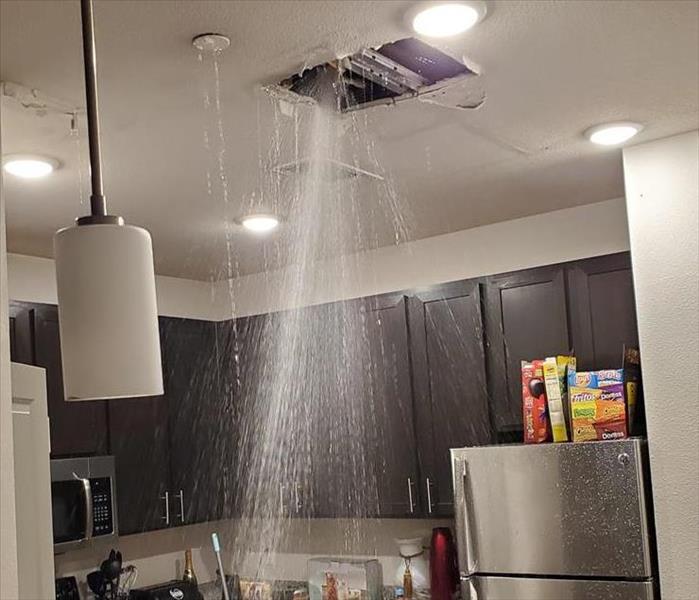 Water Pouring from a Ceiling Pipe
Water Pouring from a Ceiling Pipe
Whether it is a burst pipe like during the February winter storms or a kitchen appliance that malfunctions, a water event can happen without notice and cause lots of havoc. It is natural for people to panic when their home and property is damaged but calm is needed to go through the right steps to determine when an insurance claim is needed and if so, what are the steps that should be followed.
The first thing when something happens is to get the source stopped and ideally fixed. This may mean shutting the water off locally in the home or going to the curb to shut off the water to the entire house. The next steps should be to call a plumber and a mitigation company. The mitigation company can help get things stabilized day one and should be able to give an approximate cost to get it remediated. The first big question we have is whether to make an insurance claim or not. Take a look at your policy to see what your deductible is. Aside from the mitigation, a secondary covered cost the insurance company should cover is the reconstruction side of things. Most likely some demolition will be done during the mitigation process. A quick, rough rule of thumb is it will cost 2x's the amount of the mitigation. You do not want to make a claim if you will be under your deductible as that will typically result in a zero claim. Even if insurance is not used, it will be recorded and go against your insurance record. After deciding to make a claim or not, it is time to get a reconstruction company lined up. The mitigation company may be able to do this piece as well, or give a recommendation. Your insurance company or a trusted recommendation from a friend or family can also be a solution. If a claim is made, an insurance adjuster will be assigned to you. Keep in close contact with the adjuster. Most mitigation work will take between 3-5 days while the reconstruction piece can take a fair amount longer depending on the extent of rebuild and availability.
Reach out to SERVPRO of Southwest Dallas if a water event happens to you! We are always here to help in whatever way we can.
Common Causes of Water Damage
7/12/2021 (Permalink)
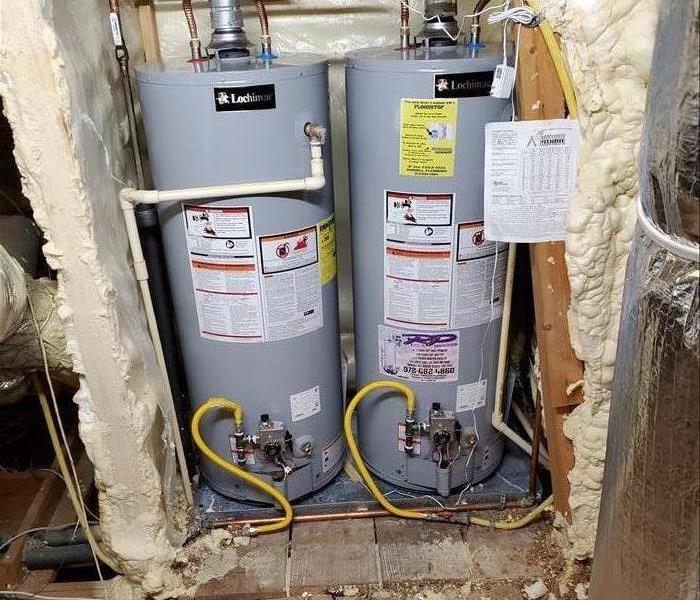 Hot Water Heaters
Hot Water Heaters
There are a number of common issues that cause water damage in buildings. Below are some of the causes and some fixes:
- Probably the most common are broken pipes. This often occurs due to age and sudden changes in weather, namely cold to hot.
- Faulty household appliances like washers, dish washing machines, hot water heaters. There are water pressure gauges & FloodStop systems that can be put in place to turn these off should something happen.
- Clogged drains. These should be cleaned regularly but it is a good idea to stay away from chemicals. In the short run chemicals do the job, in the long run they can eat through piping. Snaking the drain or calling a professional is your best bet.
- Clogged gutters. These can cause water to get diverted down a path that will flow inside the building.
- Tree roots. Make sure to monitor or remove trees that are growing next to your house. Tree roots will often grown around pipes and over time can cause cracks.
- Poor drainage. We see this an awful lot in Texas where there are no basements, instead a crawlspace will get flooded. Check your crawlspace when it rains. If there is standing water, there are some solutions but often an expert will need to be brought in.
- New construction or a remodel. Any type of construction leaves the door open for an issue to pop up whether that's an accidental nail through a pipe or a roof that wasn't sealed well.
We hope that you are able to avoid any water issues but if something should happen, SERVPRO of Southwest Dallas is here to help.
Texas Crawlspace Dry Outs
5/12/2021 (Permalink)
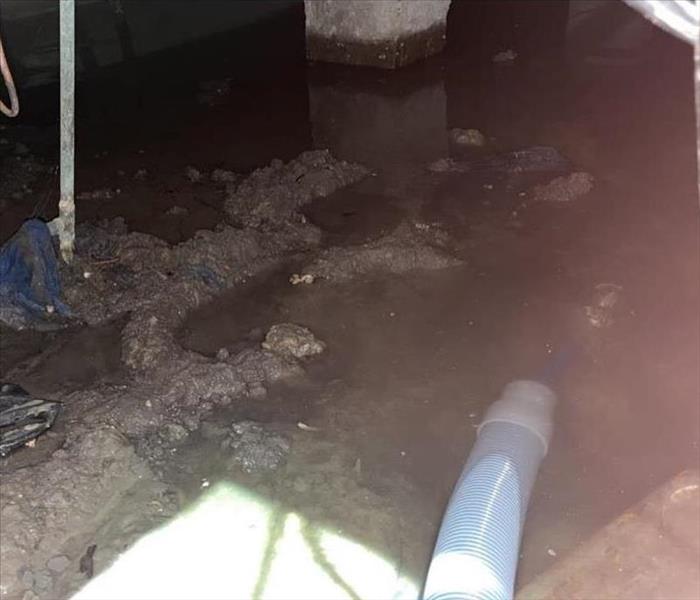 Flooded Crawlspace After Heavy Rain
Flooded Crawlspace After Heavy Rain
In Texas, we typically don't have basements. This is due to several factors. Soil can be damp or have clay in it which can expand and contract causing foundation issues. Additionally, the water table and frost line are much shallower which doesn't give the depth in the ground for a basement. Bedrock, which is found throughout a good portion of the state, also makes it expensive to dig through to build.
Without basements, houses in Texas are either built on a slab or pier and beam. Pier and beam equates to many concrete/stone/wood piers that stick out of the ground with wood beams running across the top supporting the weight of the home. Pier and beam means you will have a crawlspace.
For a variety of reasons, crawlspaces can flood. Primarily we have found this is due to poor drainage around the house when it rains. Often, older houses don't have good vapor barriers under the flooring which can allow moisture to seep under the floors and into the house. This may require extraction from the crawlspace followed by drying it out. Special tools and processes like an indirect fired heater and pulling out wet air via ducting and axial fans can assist in this situation. It is also recommended to check the humidity in the living area to make sure elevated humidity does not cause secondary damage to walls, floors, personal items, etc. Having a good water mitigation company at hand is key in these situations.
A mitigation company like SERVPRO of Southwest Dallas can help work through this issue but a permanent solution should be explored. Some homes have built in trash pumps to pump out the water anytime it floods. Other home owners may require more extensive work done such as putting in a new drainage system like French drains.
It's Cold Out There, Beware of Freezing Pipes!
2/12/2021 (Permalink)
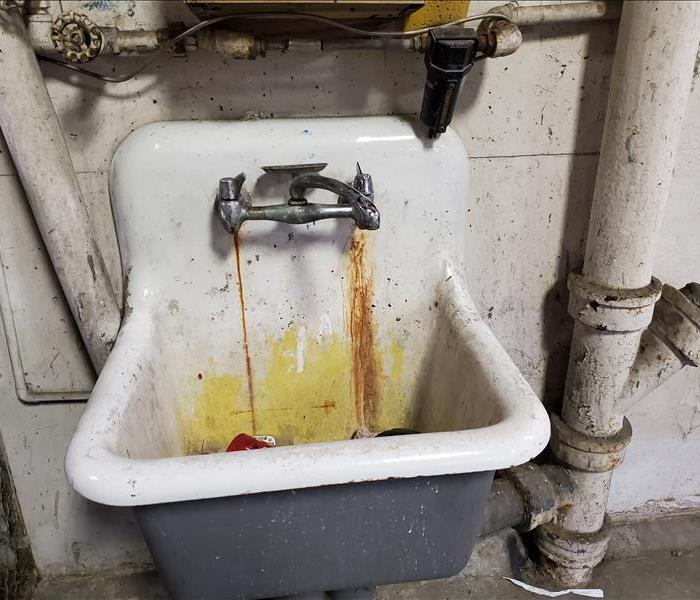 Older pipes coming out of a sink on an exterior facing wall
Older pipes coming out of a sink on an exterior facing wall
In Texas, we usually have mild winters with our coldest months being January and February. It does not often fall below freezing at 32 degrees Fahrenheit, and when it occurs it typically doesn't happen for long. Because of this, most homes and buildings are not built with pipes that are well insulated or in warmer parts of the house.
When temperatures hit 20 degrees, you can really get into the danger zone with pipes bursting. This can happen with metal and PVC pipes. Ice forms inside the pipe and creates a blockage. When water freezes, it expands building up pressure from the blockage to the faucet. Eventually it is too much and the pipe cracks or ruptures sending water everywhere.
Solutions/Tips:
-Moving water has a hard time freezing and is why it is a good idea to keep water at a trickle during these cold weather times. This does not mean you have to turn on every faucet, usually just pipes that have exposure to the cold weather like ones running along exterior walls.
-Add insulation to vulnerable pipes.
-Even if you will be gone, keep the building temperature at least 55 degrees.
-Open cabinet doors to allow warm air to circulate and reach pipes in these areas.
-Know where your area water shut-off and outside curb valves are located.
-Have the name of a good plumber on hand.
-Have the name of a good water mitigation company on hand.
At SERVPRO of Southwest Dallas, we are here to help with whatever emergency needs may arise such as a pipe bursting in wintertime. Serving the DFW area, give us a call at 214-463-5880.
Home Appliance Water Issue Statistics to Know
10/13/2020 (Permalink)
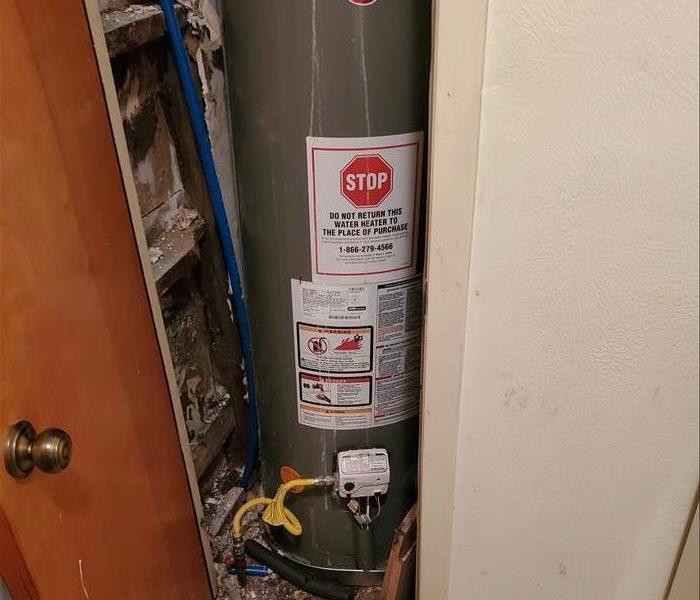 Water Heater issue in South Dallas
Water Heater issue in South Dallas
Most people in United States have water heaters with a tank. There are a number of people that have made the switch to tankless water heaters for a variety of reasons but most have not due to the added cost. 75% of tank water heaters will fail before the 12 year mark. If you are lucky enough to have your water heater approach the 10 mark, it may be time to change it out as a precautionary measure.
Washing machine supply lines typically have issues on average around the 9 year mark. As a preventative measure, have a plumber look at the supply lines and replace parts as necessary.
These are the statistics on average, of course things will happen before some of these timelines are met. SERVPRO of Southwest Dallas is here to help with any water mitigation damage needs that may arise in your home or commercial building.
Water Damage Restoration Equipment
8/20/2020 (Permalink)
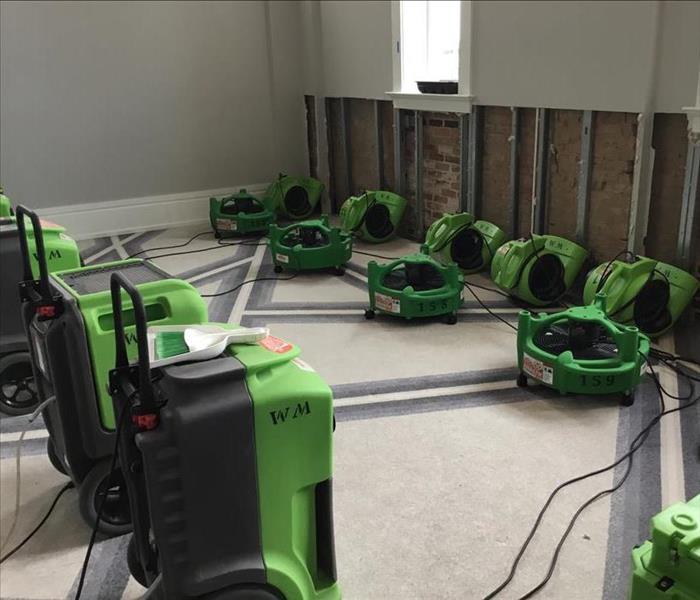 Equipment Drying out a Downtown Dallas Hotel
Equipment Drying out a Downtown Dallas Hotel
SERVPRO of Southwest Dallas has the latest equipment to help restore your water damaged commercial or residential property. We have multiple types of air movers and dehumidifiers to help dry out an area that has been affected. In addition, our warehouse keeps other equipment on hand for unfortunate disasters, such as wood floor drying mats, hydroxyl and ozone machines for odors caused by water damage, powerful space heaters for drying areas that are below the optimal temperature range, the Injectidry system for wall cavity drying, etc. Equipment, however, is not the only part of the equation when drying out a structure. Having trained and experienced technicians, such as those at SERVPRO of Southwest Dallas, is necessary in order to set up the correct amount of equipment, as well as placing it in the proper areas. If you have a water damage situation, call us today.
Water Damage - Crawl Spaces
8/15/2020 (Permalink)
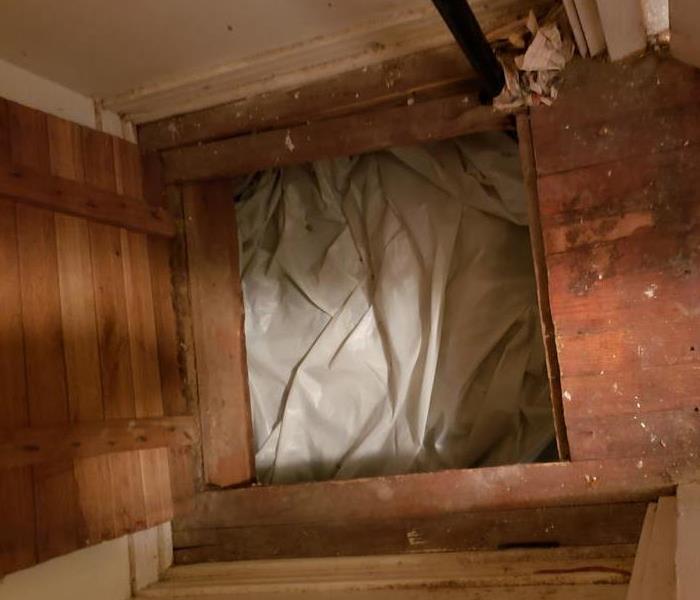 Water Damage Mitigation in a Crawl Space
Water Damage Mitigation in a Crawl Space
Crawl spaces that sustain water damage in the Dallas Fort Worth (DFW) area can be a difficult situation due to the lack of access to the confined area, the potential for contaminants that may reside in crawl space, and the potential for secondary damage to the main floor of the residence. When excess moisture or even standing water is in the crawl space due to flooding or a leak, the moisture can have a tendency to migrate to the living area of the house and cause water damage there as well, even if the water never directly touched the main floor. The first step is to extract any standing water from the crawl space. Once the water has been extracted, drying equipment, such as commercial dehumidifiers, air movers, and sometimes even portable furnaces, should be set up in order to pull the excess moisture from the affected areas and stabilize the area before additional damages, such as mold or rotting, can occur. It is also important to note that the equipment needs to be set up properly so as to not contaminate the living area of your residence with contagions from the crawl space. If you suspect water damage in your crawl space, call the experienced professionals today!
Water Damage Restoration in DFW
7/23/2020 (Permalink)
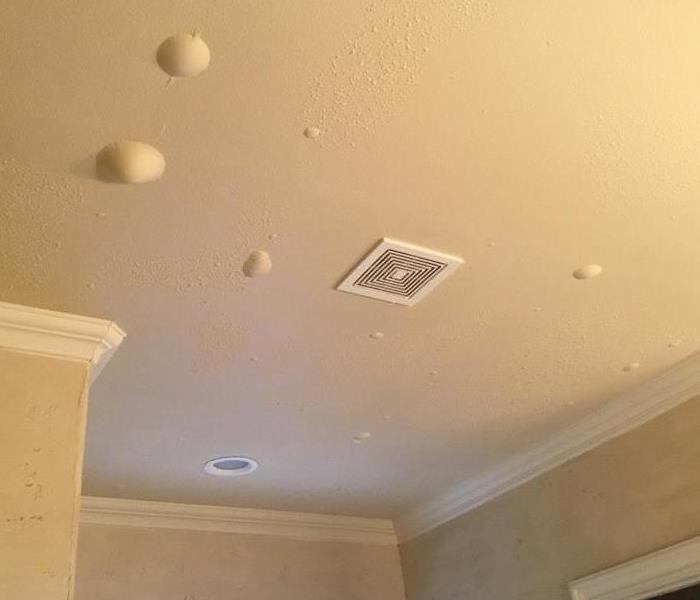 DFW water damage in a ceiling in Plano
DFW water damage in a ceiling in Plano
Water Damage Restoration Services by SERVPRO for Southwest Dallas
Water damage can be a result of several different types of losses for DFW properties, both residential and commercial. A broken pipe or appliance failure might be the first types of issues that come to mind. Storms and flooding can also bring damage to a property that requires mitigation, including biohazard-level treatments. Even destruction from a fire can include massive amounts of additional issues from the water used to extinguish the fire. When improperly cleaned, water loss can lead to the growth of mold colonies, which require professional remediation.
The type of water damage in the property matters as it affects everything from the kind of cleaning solutions needed to whether our technicians require additional protective gear to come into contact with it. The categories for water cleanup types are category one clean water, category two gray water, and category three black water, which carries a rating as a biohazard.
Cleaning up disasters that occur with residential and commercial properties requires equal parts of compassion, experience, and skill. When SERVPRO of Southwest Dallas technicians come onto a site to mitigate fire, water, or other damage of any type, we know it is likely one of the worst days of the property owner's life, and we empathize and attempt to make the remediation process as stress-free as possible. Our goal is always to restore rather than replace whenever possible, which helps reduce the amount spent on replacing damaged building materials or belongings. Time is of the essence, and We're Faster To Any Size Disaster.
The skills that each SERVPRO of Southwest Dallas technician acquires begins with the extensive and ongoing training they receive before ever setting foot onto a job site. We set up numerous scenarios for fire, water, storm, and mold damage for the technicians to learn the best practices for restoration and cleaning for every type of potential job they may find themselves on.
Along with hands-on training, our technicians pursue numerous certifications in the restoration industry as per the guidelines of the Institute of Inspection, Cleaning and Restoration Certification (IICRC.) SERVPRO of Southwest Dallas employees participate in ongoing in-house training, which starts with the ECTP-employee certification training program and continues as methods of restoration continue to advance. We utilize state-of-the-art moisture detection equipment including probes, and thermal imaging to detect anywhere water migrates in a commercial or residential property so effective removal of any elevated moisture occurs during remediation.
An essential certification that SERVPRO of Southwest Dallas employees receive is for Water Damage Restoration Technician (WRT) and much of our specialized equipment assists in the mitigation of water damage. Portable extractors are one of the most frequently used items in our restoration arsenal. They quickly pull up large amounts of water, and when needed, we add weighted extractor wands, so the water absorbed into carpet and padding can be extracted and resulting in the saving of the carpeting in clean water spills, rather than have it counted as a loss. Another type of weighted extractor that we use frequently is the highly maneuverable Rover. This stand-on vacuum uses the weight of our certified Carpet Cleaning Technicians (CCT) to push water up and out where it is then collected and removed from the flooring.
Dallas locals are no strangers to wild weather. The intense storms that roll through this area of Texas bring damages such as tree limbs through windows. High winds peeling shingles which lets rain leak in through a compromised roof or flash floods causing groundwater to enter a home are all water loss events that require professional cleaning and restoration to minimize damages to the structure and contents. The more quickly water extraction happens, the faster cleaning and water damage restoration efforts take place, which saves more articles from being counted as a loss. Our employees perform preventative measures on arrival, such as tarping over damaged roofs or putting barriers over broken windows until they can be repaired to stop any further water from entering the property.
SERVPRO of Southwest Dallas employees complete training and certification for Fire and Smoke Damage Restoration Tech (FSRT), and a crucial part of this training is the removal of water before it causes secondary damage after a fire. After extraction of as much moisture as possible, the drying phase of the restoration process begins.
In the case of both water and fire loss, SERVPRO technicians may find the property requires controlled demolition techniques such as flood cuts. When this is necessary, our technician carefully cuts away, sheetrock above the waterline, to encourage a significant amount of airflow within wall cavities for faster drying. This attention to detail can also significantly reduce reconstructions costs.
Drying a commercial or residential Big D property after a water loss is more than setting up fans to blow on wet surfaces. Our Applied Structural Drying Technicians (ASD) spend time setting up our air movers at specific angles to bank air throughout the affected areas to drive embedded moisture to the surface where strategically placed dehumidifiers capture and port away moisture allowing progressively drier air to cycle in the areas that are drying. We have specialized drying equipment such as drying mats to use in the restoration of wet hardwood flooring which can be restored on a case by case basis.
Once SERVPRO of Southwest Dallas technicians confirm drying goals are met, they move on to complete the cleaning and disinfection of all surfaces. This step is to inhibit the growth of mold and eliminate odors that water can leave behind. If the type of water loss is gray or black water, our technicians may find the situation requires stronger odor control methods.
Mold growth is a particular focus before, during, and after cleanup of water damage. Because spores can set up home as fast as 48 hours and Dallas has year-round humidity levels in the optimal range that encourages mold growth, the expedited extraction and lowering of humidity in the structure needs to occur as timely as possible after a water-damaging event. If we find mold in the structure, our employees hold a certification as an Applied Microbial Remediation Technician (AMRT) and have the expertise and equipment to perform mold remediation on all types of structures.
No one wants a reminder of that time they dealt with water damage in their home, yet odors left behind can do just that. Often cleaning and disinfection are enough to remove foul odors. In cases where it is not, our Odor Control Technicians (OCT) deploy different methods and equipment to neutralize odors at the molecular level. The assortment of hydroxyl generators, ozone machines, ULV ultra-low volume foggers, and deodorizing gels and pellets are always at the ready stored at our facility and on our Green Fleet of vehicles.
SERVPRO of Southwest Dallas at (214) 463-5880 is available 24/7 to clean up and restore any size water damage to your property and make it, "Like it never even happened."
Category 3 Water - A.K.A. Sewage
2/25/2020 (Permalink)
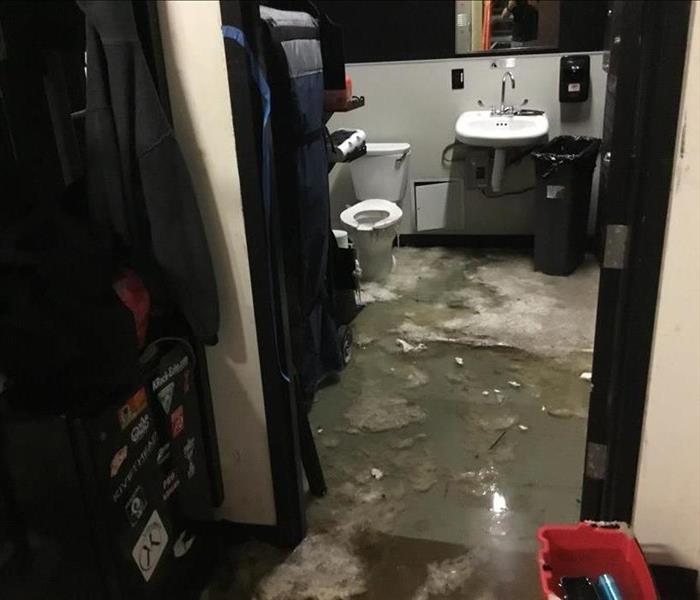 Sewage water that needed removed from a downtown Dallas commercial building.
Sewage water that needed removed from a downtown Dallas commercial building.
When Category 3 water damage, aka a sewage backup, hit a downtown Dallas commercial business, SERVPRO of Southwest Dallas was there within the hour to pump out and extract the water / sewage and help mitigate the situation. After the Cat 3 water has been removed, the problem is not yet mitigated however. Additional steps to remove porous materials, apply antimicrobial agents, clean the affected areas, and decontaminate with additional equipment is necessary. Equipment like HEPA air scrubbers, ozone machines, and hydroxyl machines are typically used to remove contaminants and dissipate odors. In addition, it is always recommended that the workers taking on these unenviable tasks wear the proper protective equipment, such as respirators and Tyvek suits. Don't take this monumental task on alone! Contact us for any water or sewage, fire, mold, or commercial cleaning needs. 24/7/365.
Water Damage - Are Flood Cuts Necessary?
2/9/2020 (Permalink)
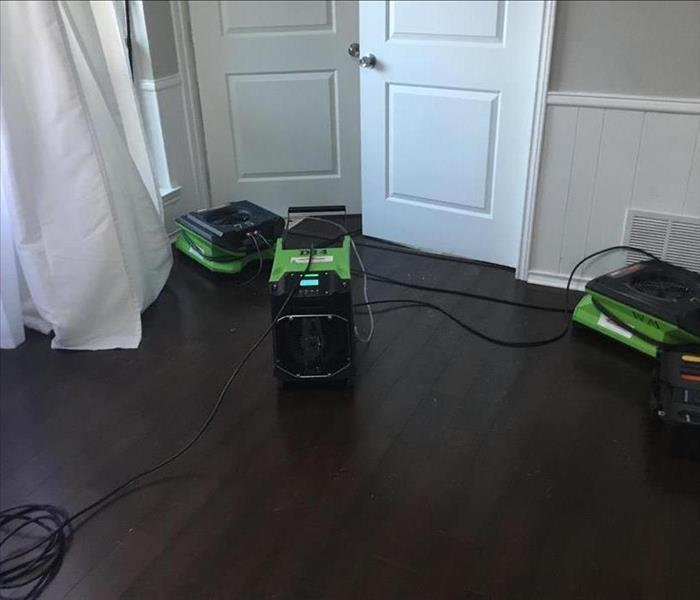 Drying equipment being used to remediate water damage in South Dallas.
Drying equipment being used to remediate water damage in South Dallas.
SERVPRO of Southwest Dallas has been repeatedly called to water damaged homes and businesses where other restoration companies told the owners that flood cuts and major demolition is necessary, but we deemed that course of action unnecessary. This is certainly concerning, because while sometimes it is necessary to remove affected materials, especially when they have degraded or been affected by Category 3 water like sewage. However, our certified professionals regularly dry areas that have been affected by water using our state of the art equipment and techniques while performing very limited demolition or flood cuts. This helps to keep the costs down, speeds up the process, and causes as little interruption to the homeowner's life or business as possible. Call SERVPRO of Southwest Dallas first for the best water damage restoration team around.
Water Damage Ready Professionals
9/24/2019 (Permalink)
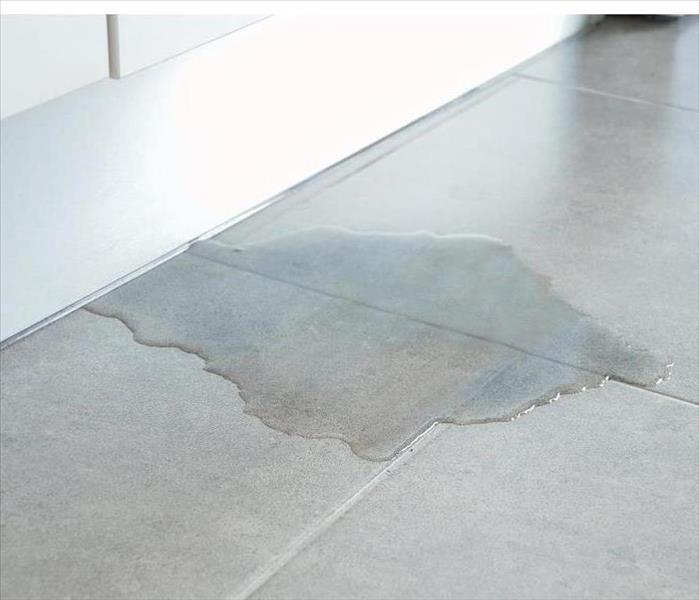 We are here to help with your water damage emergency 24/7
We are here to help with your water damage emergency 24/7
Water damage can range from minor to absolutely disastrous. When faced with residential or commercial water damage, call SERVPRO of Southwest. We are recognized as a trusted leader in the water restoration industry. As a locally owned and operated franchise, our team has the knowledge needed to solve the problem quickly.
Offering 24/7 emergency service, customers will speak directly to one of our SERVPRO professionals who are highly skilled, trained, and certified water damage technicians. Customer Service is our top priority.
As a professional water restoration company, we can work closely with your insurance agent to ensure that all of the required paperwork is completed accurately allowing the restoration process to move forward. Our team will stay in communication with you throughout the process, so timelines and expectations are clear.
At SERVPRO, we have a six-step water restoration process using advanced technology.
- Emergency Contact with our Customer Care Representative
- Inspection and Water Damage Assessment
- Water Removal and Water Extraction
- Drying and Dehumidification
- Cleaning and Sanitizing
- Restoration
We understand that every water disaster is different. SERVPRO of Southwest Dallas is here to provide unique solutions. Call us (214) 463-5880 to help you quickly recover from your next water damage emergency.
Water Damage, Flooding and Restoration
7/22/2019 (Permalink)
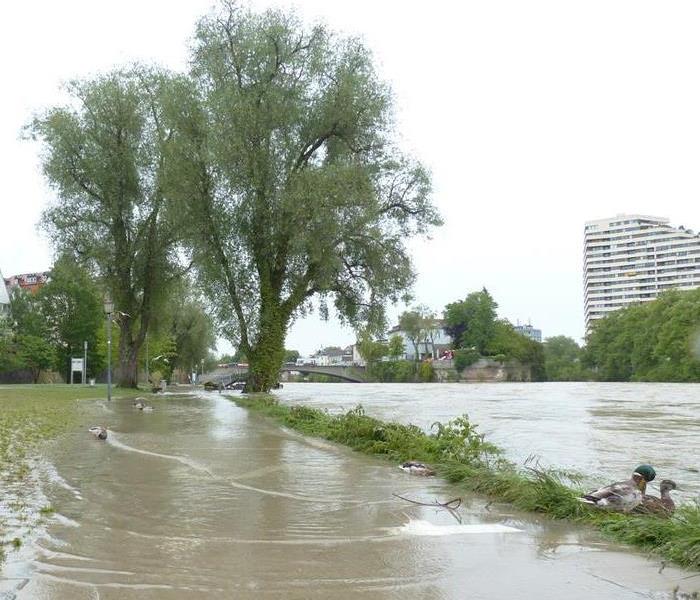 Storm Damage and Flood Waters Beware!
Storm Damage and Flood Waters Beware!
SERVPRO of Southwest Dallas is ready to assist you with any of your water, flood or fire restoration needs. To ensure the safety of your home, it is best to be proactive. Doing so will lessen the severity of water damage or flood damage.
The best prevention of water or flood damage is the inspection and maintenance of the most common causes in your home. Here are a few suggestions to help reduce the potential for damage.
- Visible hoses and pipes in your home should be inspected regularly, like, dishwashers, washing machines, refrigerators, and ice makers. Unfortunately, all of these types of appliances have hoses and pipes that in time will wear out.
- Know where the water main to your home is located. Make sure the main valve is in good working condition. Should you have an appliance flood or pipe flood in your home, one of the first things that you will need to do is shut off the water to your home, so more damage is not caused. Thus, you do not want a faulty main value since that could mean serious disaster.
- If there is a sump pump in your home, check it regularly. If it is broken or the battery backup is not working, it will be too late when you have a flood.
- Routinely check your gutters, roof, and the slope of your yard. During monsoon season or rainy season, clogged gutters are a recipe for disaster. Make sure that they are cleaned and clear of any debris.
- Make sure that the slope of your yard moves water away from your home rather than toward the foundation.
- Check for roof leaks in the attic. Don’t let them go unattended. Doing so could cause leaks not just in the attic area but throughout your home. Left unattended mold can result.
- Keep an eye on your water bill. If you notice an unexplained increase, you may have a leak inside or outside of your home. Call a professional plumber to take a look.
Should you encounter a flood disaster of any kind, call SERVPRO of Southwest Dallas (214) 463-5880. Our professionally trained team is available to help 24/7 providing fast emergency service, day or night!
We Can Save Your Water Damaged Home In Dallas
6/14/2019 (Permalink)
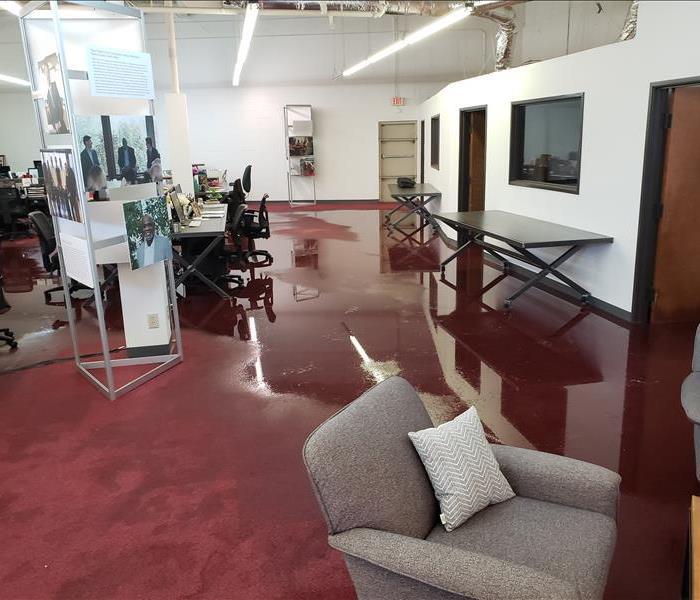 Our certified technicians are available 24-hours by calling (214) 463-5880, and we can make your water loss “Like it never even happened.”
Our certified technicians are available 24-hours by calling (214) 463-5880, and we can make your water loss “Like it never even happened.”
SERVPRO Helps Alleviate Post-Vacation Water Damage In Dallas Home
The two areas in the home most likely to suffer water damage in a Dallas home are the kitchen and bathroom. If the spill gets cleaned up quickly, it limits the amount of loss to the house; the real problem happens when an amount of time passes between the event and the cleanup.
SERVPRO answered a call from a Dallas homeowner to mitigate water damage in a kitchen from a leak under the sink. The family had left on Friday and come home on Sunday night to this scenario. They were unsure how long the water had been flowing into the room, but they had placed towels in the floor and attempted to mop up all they could. On the advice of their insurance adjuster, since it was a sudden pipe break, they contacted us for water extraction and cleanup.
Since the water could have been standing in the room for up to 48 hours, we did not treat this spill as a clean water spill because the more time that elapses between the water loss event and cleanup efforts give bacteria and mold time to set up home. Our technicians treat the water as contaminated during mitigation by wearing protective clothing and using antibacterial solutions in areas they are working.
We scoped the room to determine the areas of water migration. This action involved removing the baseboards and drilling drying holes inside the back of the cabinets to allow the water to drain so a more substantial amount of air could reach within the wall cavities and speed the drying process. The homeowner was relieved to find out through our moisture detection equipment that water did not breach the subflooring.
SERVPRO techs removed the breakfast table and chairs for drying and cleaning in another area of the home. After drying the kitchen, we thoroughly cleaned and sanitized the room to ensure it was disinfected and inhibit the growth of mold.
SERVPRO of Southwest Dallas stands ready to mitigate water damage to your home from any source. Our certified technicians are available 24-hours by calling (214) 463-5880, and we can make your water loss “Like it never even happened.”
Click here for more about Dallas.
Southwest Dallas Homeowners Count on SERVPRO for Water Loss Mitigation
6/12/2019 (Permalink)
Water Damage Restoration Services by SERVPRO for Southwest Dallas
Water damage can be a part of several different types of losses for Dallas properties, both residential and commercial. A broken pipe or appliance failure might be the first types of issues that come to mind. Storms and flooding can also bring damage to a property that requires mitigation, including biohazard-level treatments. Even destruction from a fire can include massive amounts of additional issues from the water used to extinguish the fire. When improperly cleaned, water loss can lead to the growth of mold colonies, which require professional remediation.
The type of water damage in the property matters as it affects everything from the kind of cleaning solutions needed to whether our technicians require additional protective gear to come into contact with it. The categories for water cleanup types are category one clean water, category two gray water, and category three black water, which carries a rating as a biohazard.
Cleaning up disasters that occur with residential and commercial properties requires equal parts of compassion, experience, and skill. When SERVPRO of Southwest Dallas technicians come onto a site to mitigate fire, water, or other damage of any type, we know it is likely one of the worst days of the property owner's life, and we empathize and attempt to make the remediation process as stress-free as possible. Our goal is always to restore rather than replace whenever possible, which helps reduce the amount spent on replacing damaged building materials or belongings. Time is of the essence, and We're Faster To Any Size Disaster.
The skills that each Dallas SERVPRO technician acquires begins with the extensive and ongoing training they receive before ever setting foot onto a job site. We set up numerous scenarios for fire, water, storm, and mold damage for the technicians to learn the best practices for restoration and cleaning for every type of potential job they may find themselves on.
Along with hands-on training, our technicians pursue numerous certifications in the restoration industry as per the guidelines of the Institute of Inspection, Cleaning and Restoration Certification (IICRC.) SERVPRO of Southwest Dallas employees participate in ongoing in-house training, which starts with the ECTP-employee certification training program and continues as methods of restoration continue to advance. We utilize state-of-the-art moisture detection equipment including probes, and thermal imaging to detect anywhere water migrates in a commercial or residential property so effective removal of any elevated moisture occurs during remediation.
An essential certification that SERVPRO of Southwest Dallas employees receive is for Water Damage Restoration Technician (WRT) and much of our specialized equipment assists in the mitigation of water damage. Portable extractors are one of the most frequently used items in our restoration arsenal. They quickly pull up large amounts of water, and when needed, we add weighted extractor wands, so the water absorbed into carpet and padding can be extracted and resulting in the saving of the carpeting in clean water spills, rather than have it counted as a loss. Another type of weighted extractor that we use frequently is the highly maneuverable Rover. This stand-on vacuum uses the weight of our certified Carpet Cleaning Technicians (CCT) to push water up and out where it is then collected and removed from the flooring.
Dallas locals are no strangers to wild weather. The intense storms that roll through this area of Texas bring damages such as tree limbs through windows. High winds peeling shingles which lets rain leak in through a compromised roof or flash floods causing groundwater to enter a home are all water loss events that require professional cleaning and restoration to minimize damages to the structure and contents. The more quickly water extraction happens, the faster cleaning and water damage restoration efforts take place, which saves more articles from being counted as a loss. Our employees perform preventative measures on arrival, such as tarping over damaged roofs or putting barriers over broken windows until they can be repaired to stop any further water from entering the property.
SERVPRO of Southwest Dallas employees complete training and certification for Fire and Smoke Damage Restoration Tech (FSRT), and a crucial part of this training is the removal of water before it causes secondary damage after a fire. After extraction of as much moisture as possible, the drying phase of the restoration process begins.
In the case of both water and fire loss, SERVPRO technicians may find the property requires controlled demolition techniques such as flood cuts. When this is necessary, our technician carefully cuts away, sheetrock above the waterline, to encourage a significant amount of airflow within wall cavities for faster drying. This attention to detail can also significantly reduce reconstructions costs.
Drying a commercial or residential Big D property after a water loss is more than setting up fans to blow on wet surfaces. Our Applied Structural Drying Technicians (ASD) spend time setting up our air movers at specific angles to bank air throughout the affected areas to drive embedded moisture to the surface where strategically placed dehumidifiers capture and port away moisture allowing progressively drier air to cycle in the areas that are drying. We have specialized drying equipment such as drying mats to use in the restoration of wet hardwood flooring which can be restored on a case by case basis.
Once SERVPRO of Southwest Dallas technicians confirm drying goals are met, they move on to complete the cleaning and disinfection of all surfaces. This step is to inhibit the growth of mold and eliminate odors that water can leave behind. If the type of water loss is gray or black water, our technicians may find the situation requires stronger odor control methods.
Mold growth is a particular focus before, during, and after cleanup of water damage. Because spores can set up home as fast as 48 hours and Dallas has year-round humidity levels in the optimal range that encourages mold growth, the expedited extraction and lowering of humidity in the structure needs to occur as timely as possible after a water-damaging event. If we find mold in the structure, our employees hold a certification as an Applied Microbial Remediation Technician (AMRT) and have the expertise and equipment to perform mold remediation on all types of structures.
No one wants a reminder of that time they dealt with water damage in their home, yet odors left behind can do just that. Often cleaning and disinfection are enough to remove foul odors. In cases where it is not, our Odor Control Technicians (OCT) deploy different methods and equipment to neutralize odors at the molecular level. The assortment of hydroxyl generators, ozone machines, ULV ultra-low volume foggers, and deodorizing gels and pellets are always at the ready stored at our facility and on our Green Fleet of vehicles.
SERVPRO of Southwest Dallas at (214) 463-5880 is available 24/7 to clean up and restore any size water damage to your property and make it, "Like it never even happened."
We Can Restore Your Water Damaged Dallas Kitchen To Pre-Damage Condition
4/17/2019 (Permalink)
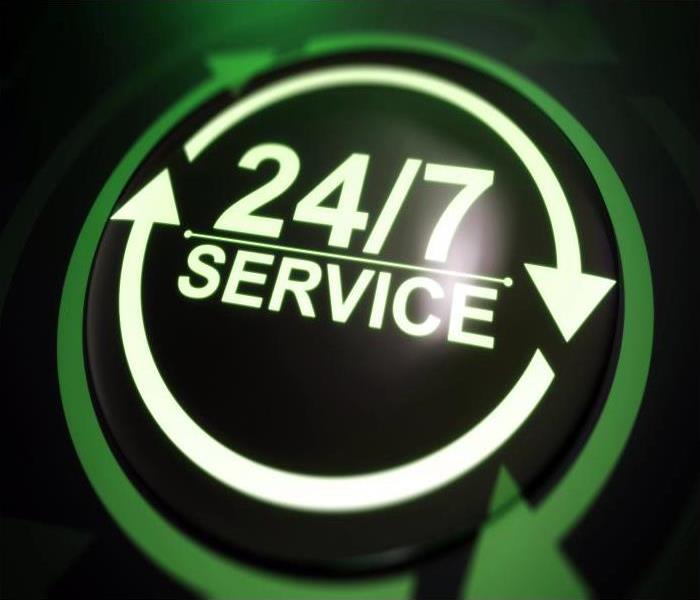 Once you realize there is an issue, call us at (214) 463-5880 so we can quickly come and help you get everything back in order.
Once you realize there is an issue, call us at (214) 463-5880 so we can quickly come and help you get everything back in order.
Water Damage Restoration In Your Dallas Kitchen
Some plumbing leaks in your Dallas home develop in areas which are easily noticeable, like the bathroom floor by the toilet or the area around the faucet. However, other leaks are much less recognizable. One place that is more difficult to see a leak is underneath your kitchen sink. These types of leaks can go unnoticed for a long time, and by then you have a good deal of damage.
You may open your cabinet underneath the kitchen sink in your home several times a day, but never more than a few seconds at a time and a leak is the last thing on your mind. By the time you do discover a leak and water damage in your Dallas home, the cabinet can already have sustained quite a bit of damage, plus there could even be mold growth. SERVPRO is always ready to help you when you discover a water damage emergency with our expertise and professional tools.
There are several plumbing components under your sink which can assist in developing a leak. Your water supply lines and valves are one such culprit. Unlike other parts under the sink, these parts are under pressure at all times. If a connection gets loose or there is a puncture in a water line, water leaks under your sink even when the faucet isn’t on.
Drying walls and floors under or behind cabinetry can sometimes be difficult. Walls behind cabinets can take longer to dry with the different layers of cabinet backing and drywall. If needed, SERVPRO techs may need to drill holes in the cabinet back to allow for air circulation. Forgetting underneath the cabinet, we may need to remove the toe kick and treat it with the appropriate biocide and utilize a vent system so dry air can be forced into the cavity. After the area is dry, we can replace this piece of the cabinet.
Leaks can also develop if you have a handheld sprayer attached to the kitchen sink. The water line for this can crack, and when the leak is low enough on the line, water drips into your cabinet below. Over time, your drain pipes can also develop a leak if they have corroded. Lastly, if the P-trap under your sink becomes clogged, it can cause water to build up to your drains and create a leak.
SERVPRO of Southwest Dallas can assist you in restoring your kitchen in Cockrell Hills, Kessler, or Oak Cliff when your sink has a water leak. Once you realize there is an issue, call us at (214) 463-5880 so we can quickly come and help you get everything back in order.
Click here for more about Dallas.
Oak Cliff Property Owners Benefit from SERVPRO Water Loss Mitigation and Disinfecting
3/4/2019 (Permalink)
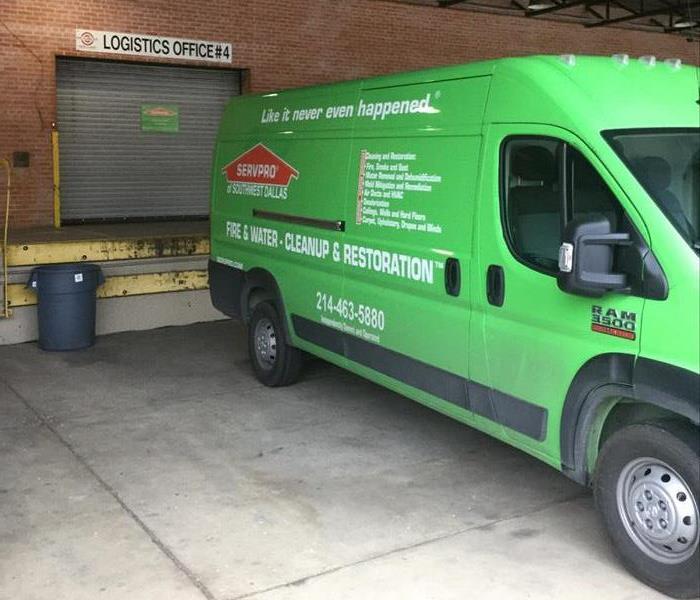 New Warehouse, But the Same Great Water Mitigation Service in Oak Cliff--SERVPRO
New Warehouse, But the Same Great Water Mitigation Service in Oak Cliff--SERVPRO
When You Spring a Leak in Your Oak Cliff Home
Sewer pipes do not break when it is most convenient. Your home needs year-round upkeep and care, but what happens when a pipe bursts suddenly in the middle of the night? You should never wait to act on water damage. SERVPRO is ready even when you are not which is why We're Faster to Any Size Disaster. Even at 3 a.m., you can reach our national call center so we can send our vans over with the equipment and technicians you need.
Don't ruin your shoes or your health trying to DIY solutions. Improper repairs and cleaning can lead to ongoing damage. SERVPRO can help mitigate water damages in your Oak Cliff home right away. When dirty water surprises you, removal and clean up needs to be quick and complete.
There are three different levels of clean, the last of which (sterile) is reserved mostly for operating rooms. For a typical home, it is the first two which are most important. Our IICRC certified technicians know how to take care of a water damaged mess.
Level one is "Sanitary," anything less is just considered dirty. Your average well-kept home is sanitary. With proper cleaning equipment that functions normally, any home can achieve this level of cleanliness easily. Any area can become unsanitary if it is not maintained properly.
The second level of cleaning is "Disinfected." If you have a broken sewer line, this is the level of clean you need. Our highly trained SERVPRO professionals use EPA registered disinfectants for the health and safety of everyone concerned. We deodorize in addition to cleaning once the initial water damage is removed and repaired. A disinfected home is considered 99% contaminant and soil free, leaving you free to return safely regardless of what type of pipe caused your water damage event.
When a pipe bursts in your home and makes a mess out of your life, call SERVPRO of Southwest Dallas at (214) 463-5880 We can help make it "Like it never even happened," so you can get back to what matters most.
Living in our area info by clicking here
How A Roof Leak Damages Your Home
1/17/2019 (Permalink)
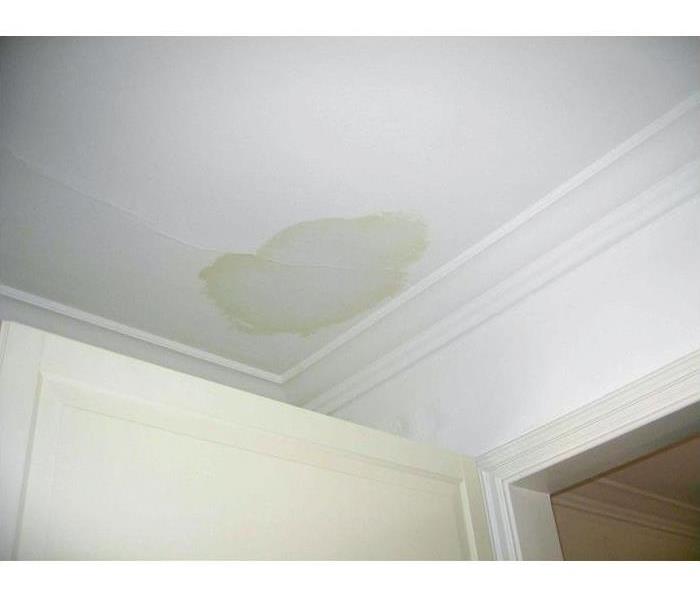 This picture shows telltale signs of a water leak. Call SERVPRO of Southwest Dallas before more damage occurs.
This picture shows telltale signs of a water leak. Call SERVPRO of Southwest Dallas before more damage occurs.
Restoring Your Water Damaged Ceiling and Walls in Dallas
If your property has a leaking roof, it is only a matter of time before water damage issues can show up. Typically the water will find its way through the ceiling, drywall and baseboard, damaging all the affected areas like cabinets, walls, and flooring. When this happens it is essential to work with professionals who use specialized equipment to remove the water and dry these areas completely. We all know that water does not require much space to penetrate through places, so you have to act promptly to prevent your Dallas property from experiencing avoidable destruction.
Choosing to not address water damage in your Dallas home can cause mold to begin to grow or deterioration of the affected materials. A combination of mold and stagnant water decreases the chance of saving and restoring your possessions. Our SERVPRO technicians use moisture sensors and thermal cameras to check whether there is moisture in the wall cavities or ceiling area. Depending on the situation, we may use penetrating or non-penetrating moisture sensors.
If an odor problem has already developed in the building, we remove the odor-causing substances and perform deodorization to neutralize such elements.
The SERVPRO of Southwest Dallas team can work directly with your insurance provider to make the claim process simple. We achieve that by recording essential details and communicating with the insurance adjuster throughout the process. We also understand the importance of letting our customers know everything about the procedures we use during the restoration process.
When your residential or commercial property has a water damage issue, call SERVPRO of Southwest Dallas to know your options. We offer emergency cleaning and restoration services at any time of the day or night, call (214) 463-5880 to work with our experienced technicians.






 24/7 Emergency Service
24/7 Emergency Service



